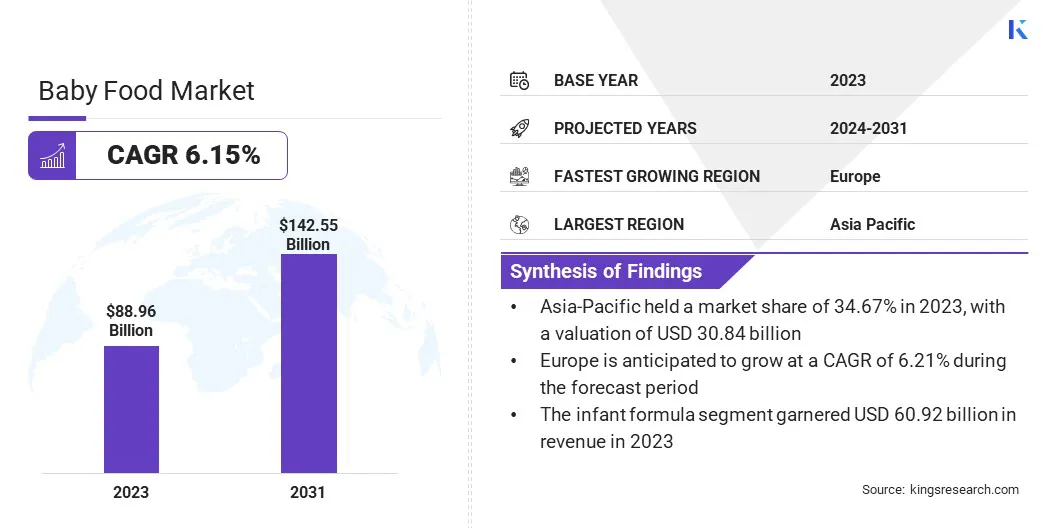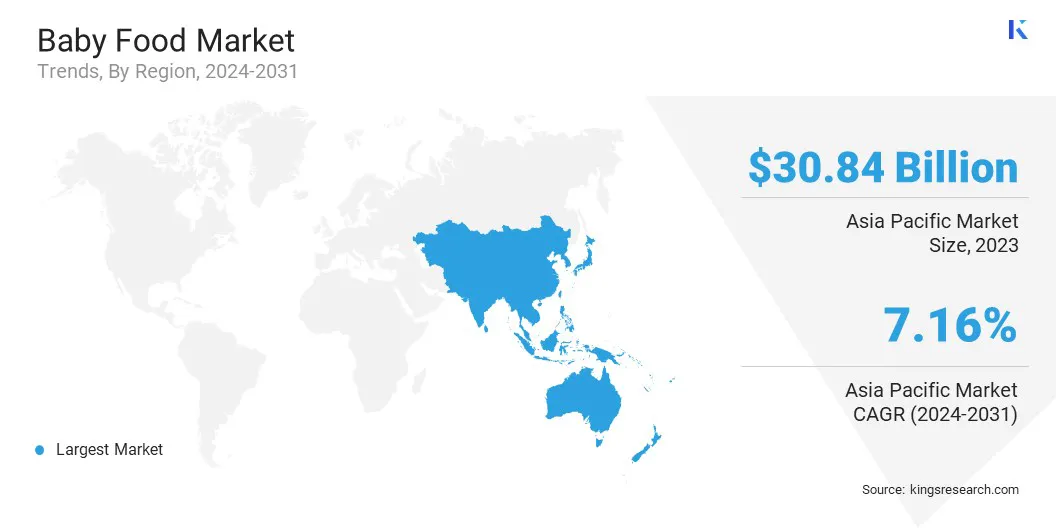Baby Food Market Size
The global Baby Food Market size was valued at USD 88.96 billion in 2023 and is projected to grow from USD 93.84 billion in 2024 to USD 142.55 billion by 2031, exhibiting a CAGR of 6.15% during the forecast period. The expansion of the market is driven by rising health awareness among parents, increasing demand for organic products, and growing dual-income households seeking convenient feeding solutions.
In the scope of work, the report includes products offered by companies such as Abbott, Alter S.L., Asahi Group Foods, Ltd., Danone, Hero Group, Hipp GmbH, Kewpie Corporation, Nestlé SA, PZ Cussons, The Kraft Heinz Company., and others.
The growth of the baby food market is further fueled by the increasing awareness regarding infant nutrition and the rising number of working parents. Additionally, the expansion of the middle class population in emerging economies boosts the demand for premium baby food products. Health-conscious parents increasingly seek organic and non-GMO options, which further propels market growth. Technological advancements in food processing and packaging enhance both product safety and shelf life, making it more appealing to consumers.
Moreover, favorable government initiatives promoting child health and nutrition support market expansion. The growing trend of online retail and e-commerce platforms provides convenient access to a variety of baby food products, thereby stimulating market growth.
- According to the India Brand Equity Foundation, India’s e-commerce industry is expected to reach USD 300 billion by 2030. In fiscal year 2023, platforms achieved USD 60 billion GMV, a 22% increase from the previous year. The Government e-Marketplace (GeM) platform’s GMV has doubled to exceed USD 47.96 billion in FY24, driven by a 205% rise in service procurement, which contributes nearly 50% of the total GMV.
The global market comprises various product categories, including infant formula, baby snacks, and ready-to-eat meals. Companies are actively focusing on product innovation and the development of organic and natural baby food to meet changing consumer preferences. Major players are expanding their presence through strategic partnerships and acquisitions. Regional markets in Asia-Pacific and Latin America are experiencing rapid growth due to rising disposable incomes and rapid urbanization. Regulatory frameworks and safety standards play a crucial role in shaping the market landscape.
The baby food market refers to the sector involved in the production and distribution of food products specifically designed for infants and toddlers. These products include infant formula, purees, cereals, snacks, and beverages, specifically formulated to meet the diverse nutritional needs of young children. The market caters to parents seeking convenient, nutritious, and safe feeding options for their babies.
Baby food products are typically categorized based on age groups, such as stage 1 (0-6 months), stage 2 (follow on/6-12 months), and stage 3 (growing-up milk-toddlers). The market encompasses an extensive range of offerings, from conventional to organic and non-GMO products, to cater to diverse consumer preferences.

Analyst’s Review
Manufacturers in the baby food market are increasingly focusing on innovation and product diversification to meet evolving consumer demands. Companies are heavily investing in the development of organic and non-GMO baby food products to address the growing health consciousness among parents. Efforts are being taken to enhance food safety by leveraging advanced processing technologies.
The evolving supportive government regulations are prompting manufacturers to diversify their product offerings. As baby food is a highly sensitive food product for a vulnerable demographic, government regulatory bodies are enforcing stringent regulations. there is stringent implementation of regulations by the regulatory bodies.
- There is an ongoing effort to improve transparency and oversight in the product offerings by manufacturers. For instance, in August 2023, the U.S. Food and Drug Administration issued warning letters to Mead Johnson Nutrition, ByHeart Inc., and Perrigo Wisconsin, LLC for violations of infant formula regulations. These warnings followed FDA inspections and product recalls related to Cronobacter sakazakii
To maintain a competitive advantage, manufacturers are advised to prioritize transparency in labeling and sourcing. Expanding online retail channels and offering subscription-based services are likely to enable companies to boost their market presence. Continued investments in research and development are essential to meet stringent regulatory standards and evolving consumer preferences.
Baby Food Market Growth Factors
The growing health consciousness among parents is a prominent factor propelling the growth of the baby food market. Parents are increasingly becoming aware of the importance of providing their infants with high-quality, nutritious food. This awareness is leading to a higher demand for organic and non-GMO baby food products, which are perceived as safer and healthier options.
Moreover, the rise in dual-income households is contributing to marketgrowth, as working parents are actively seeking convenient and ready-to-eat baby food solutions. This trend is prompting manufacturers to innovate and develop products that cater to these health-conscious consumers, thereby propelling market expansion.
Ensuring product safety and quality poses a key challenge to the growth of the baby food market. Contamination and recalls due to unsafe ingredients or production processes are ongoing concerns. To overcome this challenge, companies are implementing stringent quality control measures and are adhering to strict regulatory standards. Investing in advanced testing technologies and maintaining transparency in sourcing and production processes are playing an important role.
Furthermore, educating consumers regarding these safety measures helps build trust and confidence in the brand. By prioritizing safety and quality, the industry is mitigating risks and ensuring that products meet the highest standards, thereby creating a conducive environment for market development.
Baby Food Market Trends
The growing shift toward organic baby food is a significant trend in the market. Parents are increasingly prioritizing natural and organic ingredients to ensure the health and safety of their infants. This trend is prompting manufacturers to develop and offer a wider range of organic baby food products, including purees, snacks, and cereals.
The growing preference for organic products is influenced by concerns regarding the potential health risks associated with pesticides and artificial additives. Organic baby food is gaining significant popularity, with companies investing substantially in organic certifications and transparent labeling to evolving consumer demands and build brand trust.
The rise of e-commerce platforms is transforming the baby food market. Parents are increasingly adopting online shopping for convenience and access to a wider variety of products. This trend is compelling baby food manufacturers to strengthen their online presence and collaborate with e-commerce retailers. Subscription-based delivery services are significantly becoming popular, offering parents regular and hassle-free access to baby food products. The convenience of doorstep delivery and the ability to compare products and prices online are several factors propellingthis trend. E-commerce is becoming a crucial sales channel for baby food, significantly influencing market dynamics.
Segmentation Analysis
The global market is segmented based on type, nature, sales channel, and geography.
By Type
Based on type, the market is categorized into dried baby foods, prepared baby food, infant formula, and others. The infant formula segment led the baby food market in 2023, reaching a valuation of USD 60.92 billion. The infant milk formula is further divided into stage 1 (0-6 months), stage 2 (follow on/6-12 months), stage 3 (growing-up milk-toddlers), and specialty baby milk formula. The segment is expanding rapidly due to increasing awareness regarding the nutritional benefits of infant formula. Working parents prefer infant formula for its convenience and ease of preparation.
Moreover, advancements in formula composition and, close stimulation of breast milk, makes baby products more appealing. Rapid urbanization and the rise in disposable incomes contribute significantly to the growth of the segment. Furthermore, infant formula is often recommended by healthcare professionals for mothers who are unable to breastfeed, thereby boosting its market presence.
By Nature
Based on nature, the market is classified into organic and conventional. The organic segment is poised to witness significant growth at a robust CAGR of 7.60% through the forecast period (2024-2031). This growth is largely attributable to increased consumer awareness regarding health and wellness. Parents are increasingly opting for organic baby food to avoid exposure to pesticides, chemicals, and genetically modified organisms.
Moreover, the growing clean-label trend, emphasizing natural and minimally processed ingredients, is leading to Increased demand. Regulatory support for organic farming practices further boosts this segment. Additionally, premium pricing of organic products reflects consumer willingness to pay more for perceived higher quality and safety, which is supporting the expansion of the segment.
By Sales Channel
Based on sales channel, the market is segmented into hypermarket/supermarket, specialty store, pharmacy & drug store, online retails, and others. The hypermarket/supermarket segment secured the largest baby food market share of 38.90% in 2023. This considerable progress is stimulated by its ability to offer a wide variety of baby food products under one roof. Consumers increasingly prefer these stores due to their convenience, accessibility, and competitive pricing.
Hypermarkets and supermarkets offer an extensive range of products, allowing parents to compare and choose the best options for their infants. The availability of in-store promotions and discounts further attracts customers. Additionally, the presence of knowledgeable staff to assist with product information enhances the shopping experience.
Baby Food Market Regional Analysis
Based on region, the global market is classified into North America, Europe, Asia-Pacific, MEA, and Latin America.

Asia-Pacific baby food market share stood around 34.67% in 2023 in the global market, with a valuation of USD 30.84 billion. The region is dominating the market as a result of rapid urbanization and increasing disposable incomes that foster the demand for convenient and nutritious baby food products. The high birth rate in countries such as China and India contributes significantly to regional market growth. In addition, rising awareness regarding infant nutrition, the availability of diverse baby food products is enhancing market penetration. The region's strong retail infrastructure, coupled with a growing middle-class population, further supports market expansion.
Europe is poised to experience significant growth at a CAGR of 6.21% over the forecast period, mainly due to a rising preference for organic and high-quality products. Increased awareness regarding the importance of infant nutrition is resulting in the surging demand for premium baby food options. The region's stringent regulatory standards ensure product safety and quality, thereby attracting health-conscious parents. Additionally, innovations in product formulations and packaging are appealing to consumers, thus bolstering domestic market progress.
Competitive Landscape
The global baby food market study will provide valuable insight with an emphasis on the fragmented nature of the industry. Prominent players are focusing on several key business strategies such as partnerships, mergers and acquisitions, product innovations, and joint ventures to expand their product portfolio and increase their market shares across different regions. Manufacturers are adopting a range of strategic initiatives, including investments in R&D activities, the establishment of new manufacturing facilities, and supply chain optimization, to strengthen their market standing.
List of Key Companies in Baby Food Market
Key Industry Development
- April 2024 (Expansion): Else Nutrition Holdings Inc. launched its 'Follow-On' formula for infants aged 6-12 months in Australia. This marked the first sale of the formula outside of New Zealand. The company further introduced its Toddler Drink for ages 12-36 months. Both products, which are manufactured using plant-based ingredients, were made available on Amazon in Australia. Produced in Europe, the company adhered to strict quality and nutritional standards.
The global baby food market is segmented as:
By Type
- Dried Baby Foods
- Prepared Baby Food
- Infant Formula
- Stage 1(0-6 Months)
- Stage 2 (Follow on/6-12 Months)
- Stage 3 (Growing-up Milk-Toddlers)
- Specialty Baby Milk Formula
- Others
By Nature
By Sales Channel
- Hypermarket/Supermarket
- Specialty Store
- Pharmacy & Drug Store
- Online Retails
- Others
By Region
- North America
- Europe
- France
- UK
- Spain
- Germany
- Italy
- Russia
- Rest of Europe
- Asia Pacific
- China
- Japan
- India
- South Korea
- Rest of Asia Pacific
- Middle East & Africa
- GCC
- North Africa
- South Africa
- Rest of Middle East & Africa
- Latin America
- Brazil
- Argentina
- Rest of Latin America


